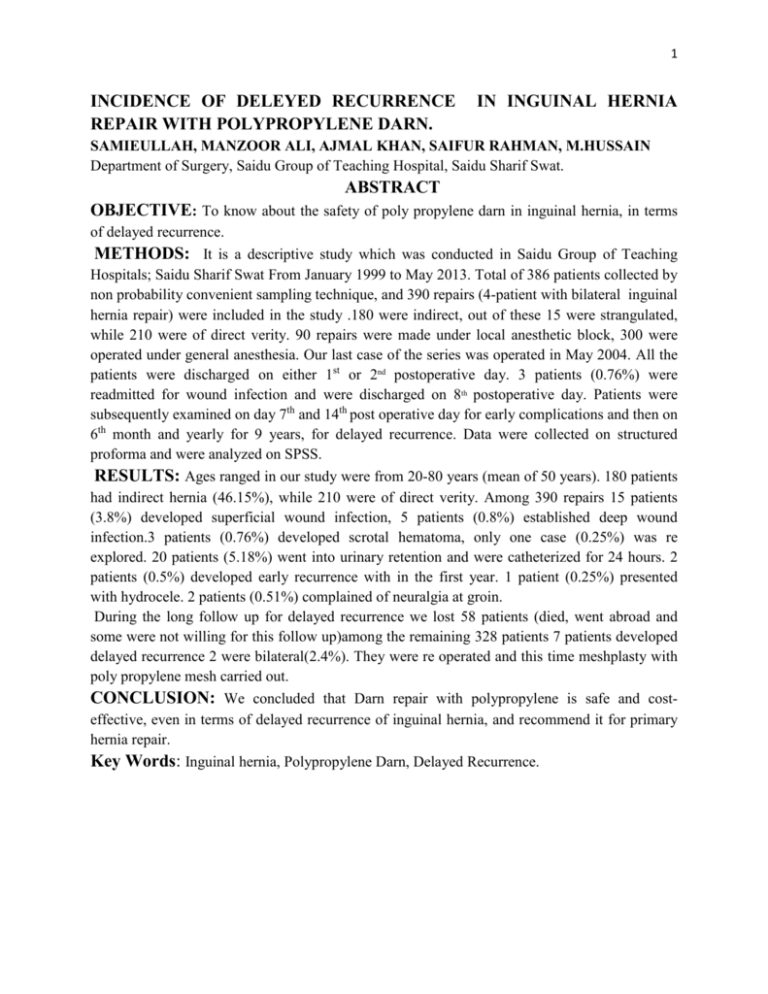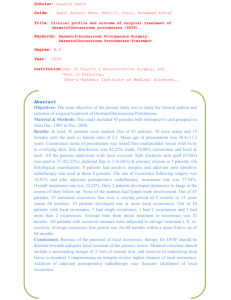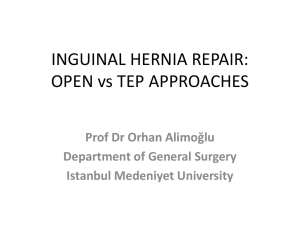incidence of deleyed recurrence in inguinal hernia repair with
advertisement

1
INCIDENCE OF DELEYED RECURRENCE
REPAIR WITH POLYPROPYLENE DARN.
IN INGUINAL HERNIA
SAMIEULLAH, MANZOOR ALI, AJMAL KHAN, SAIFUR RAHMAN, M.HUSSAIN
Department of Surgery, Saidu Group of Teaching Hospital, Saidu Sharif Swat.
ABSTRACT
OBJECTIVE: To know about the safety of poly propylene darn in inguinal hernia, in terms
of delayed recurrence.
METHODS: It is a descriptive study which was conducted in Saidu Group of Teaching
Hospitals; Saidu Sharif Swat From January 1999 to May 2013. Total of 386 patients collected by
non probability convenient sampling technique, and 390 repairs (4-patient with bilateral inguinal
hernia repair) were included in the study .180 were indirect, out of these 15 were strangulated,
while 210 were of direct verity. 90 repairs were made under local anesthetic block, 300 were
operated under general anesthesia. Our last case of the series was operated in May 2004. All the
patients were discharged on either 1st or 2nd postoperative day. 3 patients (0.76%) were
readmitted for wound infection and were discharged on 8th postoperative day. Patients were
subsequently examined on day 7th and 14th post operative day for early complications and then on
6th month and yearly for 9 years, for delayed recurrence. Data were collected on structured
proforma and were analyzed on SPSS.
RESULTS: Ages ranged in our study were from 20-80 years (mean of 50 years). 180 patients
had indirect hernia (46.15%), while 210 were of direct verity. Among 390 repairs 15 patients
(3.8%) developed superficial wound infection, 5 patients (0.8%) established deep wound
infection.3 patients (0.76%) developed scrotal hematoma, only one case (0.25%) was re
explored. 20 patients (5.18%) went into urinary retention and were catheterized for 24 hours. 2
patients (0.5%) developed early recurrence with in the first year. 1 patient (0.25%) presented
with hydrocele. 2 patients (0.51%) complained of neuralgia at groin.
During the long follow up for delayed recurrence we lost 58 patients (died, went abroad and
some were not willing for this follow up)among the remaining 328 patients 7 patients developed
delayed recurrence 2 were bilateral(2.4%). They were re operated and this time meshplasty with
poly propylene mesh carried out.
CONCLUSION: We concluded that Darn repair with polypropylene is safe and costeffective, even in terms of delayed recurrence of inguinal hernia, and recommend it for primary
hernia repair.
Key Words: Inguinal hernia, Polypropylene Darn, Delayed Recurrence.
2
INTRODUCTION:
Hernia is a common health problem, mainly effects the male population. Incidence ranges from
3-4% among the males1,2. Right inguinal hernia leads in number than left3. Since the introduction
of Bassini method in 1887, more than 70 types of tissue repair have been reported in the
literature 4. An unacceptable recurrence rate and prolonged postoperative pain led to the concept
of tension free repair. Surgery for inguinal hernia has undergone numerous advances in the last
two decades, the use of prosthetic mesh, the concept of tension free technique, and the
postoperative rate of recurrence after Bassini or shouldice operations have completely changed
the surgical approach towards the hernia repair5,6,7.The recognition that excessive suture line
tension was primarily responsible for high recurrence rate and significant postoperative pain, led
to the introduction of The concept of tension free repair of hernia8 Despite all these advances, the
best method for inguinal hernia repair has not yet been established9. Lichtenstein et al, used to
put mesh, reported in their series less than 1% recurrence rate, but mesh repair is an expensive
procedure and if mesh gets infected may require mesh removal10. Darn repair originally
described by Moneley et al is cheap and easily performed alternative to mesh the recurrence rate
reported is similar to that described by the Lichtenstein et al, less than 1% regarding the early
recurrence6,11,12. Open inguinal repair with a non absorbable darn is equivalent to polypropylene
mesh in respect to early measures of postoperative outcome and recurrence at one year13. Darn
makes a tension free lattice on which is laid a buttress of fibrous tissue reinforcing the posterior
wall, and carrying minimal risk of infective complications14. The newer technique, which is
gaining popularity now is the laparoscopic mesh repair, the recent studies conducted show that
this technique is only superior in case of recurrent and bilateral hernias15. Conventional open
surgery, which can be performed under local anesthesia, is safe and is recommended in unilateral
uncomplicated primary hernias16.The low operative cost, minimal early complications and
decrease rate of delayed recurrence of hernia, makes it the ideal method of repair.
MATERIALS AND METHODS
Total of three hundred and eighty six patients collected by non probability convenient sampling
technique were included in the study and 390 repairs (4 patients with bilateral inguinal hernias
repair) were included in the study. 180 herniae were indirect, Out of these 15 were strangulated,
while 210 were of direct verity. 90 repairs were made under local anesthetic block, 300 were
operated upon under general anesthesia .All the patients were discharged either on 1st or 2nd
postoperative day. 3 patients were readmitted for wound infection and were discharged on 8th
postoperative day. Patients were examined on day 7th and 14th postoperative day, for early
complications and then subsequently on 6th months and yearly upon request for 9 years for
delayed recurrence. Last case of the series was operated upon in May 2004. The data was
collected on a structured proforma and was analyzed.
3
RESULTS
Total of 386 patients and 390 repairs were included in the study with mean
age of 50 Years (2
0 - 80 years). 180 (46.15%) patients were having indirect inguinal hernia while 210
(53.84%) were of direct verity. 15 patients(3.8%) were having complicated(strangulated)
hernias. Right sided hernias,{224 patients (58%)} were more in number, while 158
patients(41%) had left sided hernia, only 4 patients (1%) presented with bilateral hernia. 99
patients (25.3%) presented with complete hernia, the remaining 291 (74.61%) were of
incomplete type.
Among the complicated cases two patients(0.51%) had gangrenous small bowel loop ,in
whom resection and end to end anastamosis were carried out , followed by darn repair for
hernia. These 2 patients were retained in the ward for 7 days. All the patients recovered very
smoothly; there was no case of thrombotic complication.
Regarding the early complications, 48 patients (12.3%) developed some sort of complication after
the surgery that has been shown in table no 1, while in long term follow up for delayed
complication(recurrence), 58 patients were lost from the study either died, went abroad or become
reluctant to prolong follow up during the course. Out of the remaining 328 patients, 7patients developed
recurrence and one patient developed recurrence on both sides. All recurrences were of direct type. Total
recurrence was 8(one patient with bilateral recurrence) out of 330 repair (2.4%). Shown in table no:2.
Table no:1 Showing early complication of prolene darn herniorraphy
NO Of patients
15
05
03
20
02
01
02
Complication
Superficial wound infection
Deep wound infection
Scrotal haematoma
Acute urinary retention
Recurrence
Hydrocele
Residual Neuralgia
Percentage
3.8%
1.28%
0.76%
5.12%
0.5%
0.25%
0.5%
Table no:2 Showing delayed recurrence rate in darn herniorraphy.
Number of patients Years of F/up
Total no. of patients Percentage
left for follow up
developed recurrence
328
9 years
7
patients
8 2.4%
Recurrence (1- B/L)
The last case of the series was operated upon in May 2004, and was followed upon till May
2013.
4
The patients who developed complication were treated according to the severity and the
type of complication. 15 patients (3.8%) developed superficial wound infection, and were
treated with hot fomentation and antiseptic dressing in the OPD. 5 patients (1.28%) had
established wound infection and were treated by wound drainage, antiseptic dressing and
change of antibiotics to oral Cefixime(Cephalosponrine) 400mg once aday for 10 days, in 3
patients . 3 patients (0.76%) developed scrotal heamatoma , one was treated conservatively and
the second by needle aspiration and the 3rd one re-explored .20 patients went into urinary
retention, these were all old age patients and were among those who were operated under
general Anesthesia .They were catheterized for 24 hours ,2 patients (0.51%)developed
recurrence , during the intial follow up of first year, and were re- operated, but this time mesh
plasty using prolene mesh carried out.Both the recurrences were of direct verity . One patient
(0.25%) presented with hydrocele after 20 months of follow up, that was small enough in
amount and aspirated. 2 patients (0.5%) were complaining of residual neuralgia, responded well
to local steroid injection.
Those patients who developed delayed recurrence during the period of follow up were counseled
for re operation and this time poly propylene meshplasty with prolene mesh (6 x 11cm) carried
out. All patients were given Moxifloxacin infusion 400mg once a day for two days and than
continued with oral Moxifloxacin 400mg once a day for 5-10 days.
DISCUSSION
Inguinal hernia surgery has undergone numerous advances in the past few years. It is since
1884, when Bassini started the modern surgical operation for inguinal hernia repair. Hernia
surgery is one of the most common surgical procedures performed by the general surgeons
today , yet the best method for inguinal hernia repair has not been established (9,10) .In the new
millennium ,the surgeons have clear alternatives : tension repair and tension free repair which
may be open , or laparoscopic (15). The laparoscopic inguinal hernia repair, and its technique is
still in infancy in our setup and is matter of great controversy(16, 18). Studies from the improved
centers show good results as compared to the open conventional methods of repair, regarding
the early recurrence and residual neuralgia (19,20). However various studies still recommend
laparoscopic repair for bilateral and recurrent herniae (5,10, 18).
Laparoscopic repair gain
popularity ,for less postoperative pain ,early recovery ,good cosmesis and for other diagnostic
purposes ,however it is more demanding in sense of learning and very much expensive (10,18,20) .
The ideal operation for hernia repair must be able to deal with small as well as large
defects, complicated as well as uncomplicated hernia .The technique must be simple, easily
performed and cheap (21) . One can say that darn repair is simple, cheap and can be easily
performed. The results it yield in expert hands is either equivalent or superior to other method of
repair.vIn our study the infection rate was 1.28% comparable to other studies(20, 22, 23, 24,26)
Management in case of darn is also very simple as compared to mesh repair as minimal amount
of foreign material is incorporated (24). Simple stitch removal and antiseptic dressing was
sufficient in our study.
5
We in our study found only 5.18% patients ,who went into urinary retention .They were all old
people and were operated under general anesthesia .Similar result are also demonstrated by other
studies (10,25,26,26,28)
Average time for the completion of the procedure in our study was 45_+ 10 min, less than the
time mentioned in other studies for the standard bassini repair and mesh plug methods (28).
We experienced very low rate of early recurrence 0.5%; similar results are show by other studies
(10,11, 22, 26, 27, 28)
.Our less recurrence rate may be due to our small simple size. The level of
recurrence is comparable to the Lichtenstein mesh repair, and more improved from the result of
the shouldice repair, more than 1.1% described in the various studies ( 23 ,24 ,25).
Mesh hernioplasty requires prosthetic mesh, which is very much expensive, and technically more
demanding as compared to simple prolene darn and carries more risk of
residual
(10,29,30)
neuralgia
, and if gets infected may need removal.
In the second phase of our study, we followed our patients for long period of about 9 years for
delayed recurrence, we lost 58 patients reasons already been discussed while 328 patients
showed very good compliance for follow up visits, among them we found delayed recurrence in
7 patients(8 recurrence, one patient with bilateral recurrence) about 2.4% recurrence rate,all were
direct verity and all the patients were labrourer by occupation, four patients also had symptoms
of prostatism. Recurrence rate in our long follow up patients is high compared with the study
conducted by Mumtaz et al at LRH which shows only 1.5% recurrence(22,23). Our high recurrence
may be explained for heavy work and staining at micturation because of enlarge prostate in our
patients.
Conclusion: We conclude from our study that inguinal hernia repair by polypropylene (prolene)
darn is safe and cost-effective in terms of early post operative morbidity and delayed recurrence
of groin hernia.
6
For correspondence please.
Dr Samieullah,
Associate professor surgery,
Saidu Medical college Swat.
Samiullah_dr@yahoo.com







